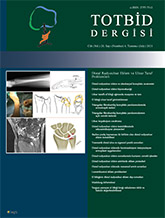
Ulnar sided wrist pain is one of the common causes of upper extremity functional limitations. Since the ulnar side wrist has a complex anatomical structure, differential diagnosis is important. On the way to this differential diagnosis, the anamnesis of the patient, a complete physical examination of the hand and the accompanying imaging methods are crucial. In this article, it is aimed to present the details of the examination required for this differential diagnosis. In the anamnesis, the occupations of the patient, the dominant hand, pain characteristics, pain duration, severity of the pain, and accompanying symptoms should be questioned. Inspection, range of motion, palpation, vascular and neurological examination should be performed by comparing the opposite side with the hand. Foveal sign, Grind test, ballotment test, ulnocarpal stress test, midcarpal shift test also constitute specific tests that complete the examination of ulnar side wrist pains. Radiocarpal and midcarpal local anesthetic injections may be helpful in the differential diagnosis. Osseous pathologies (hamate fracture, pisiform fracture, ulna styloid fracture, fifth metacarpal basis fracture), triangular fibrocartilage complex, radioulnar joint (radioulnar joint instability, ulnocarpal impingement syndrome), carpal instability (triquetrolunate instability, midcarpal instability syndrome), neurological (ulnar nerve entrapment in the Guyon canal, ulnar dorsal sensory nerve neuritis), tendon (extensor carpi ulnaris, flexor carpi ulnaris) related diseases should be considered in differential diagnosis.